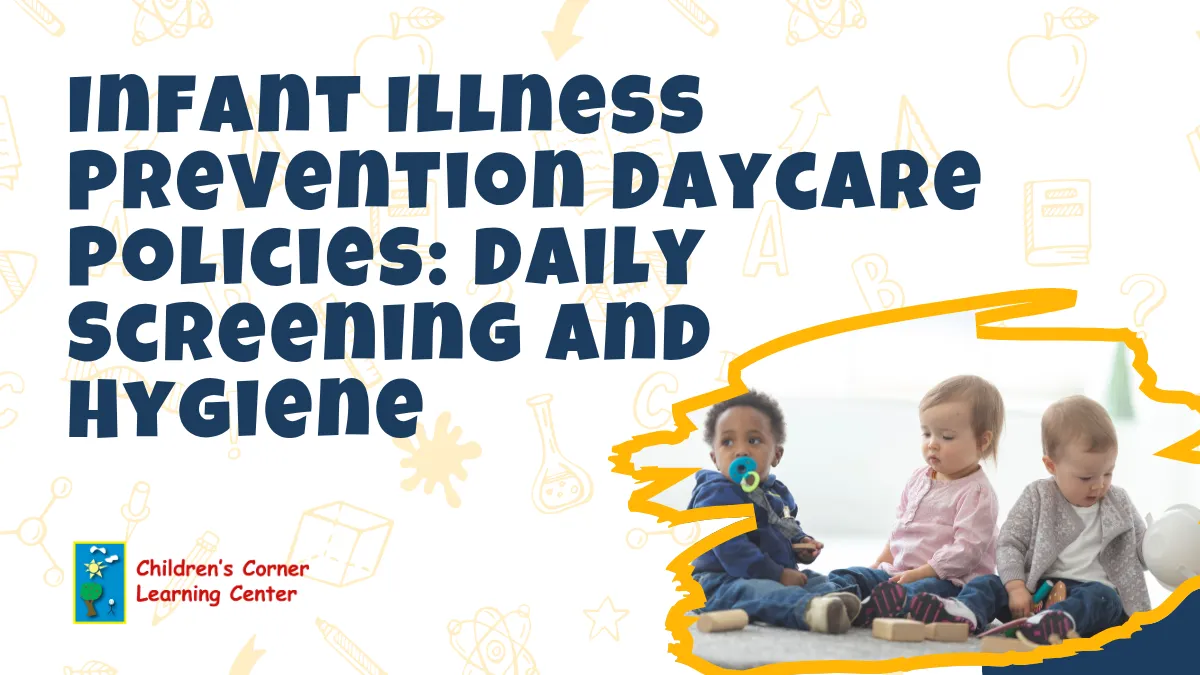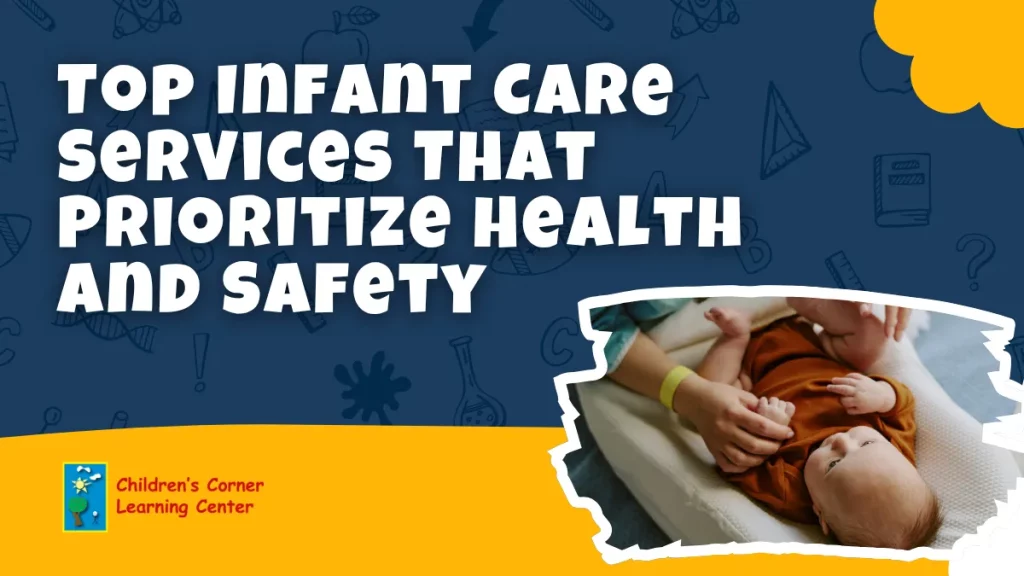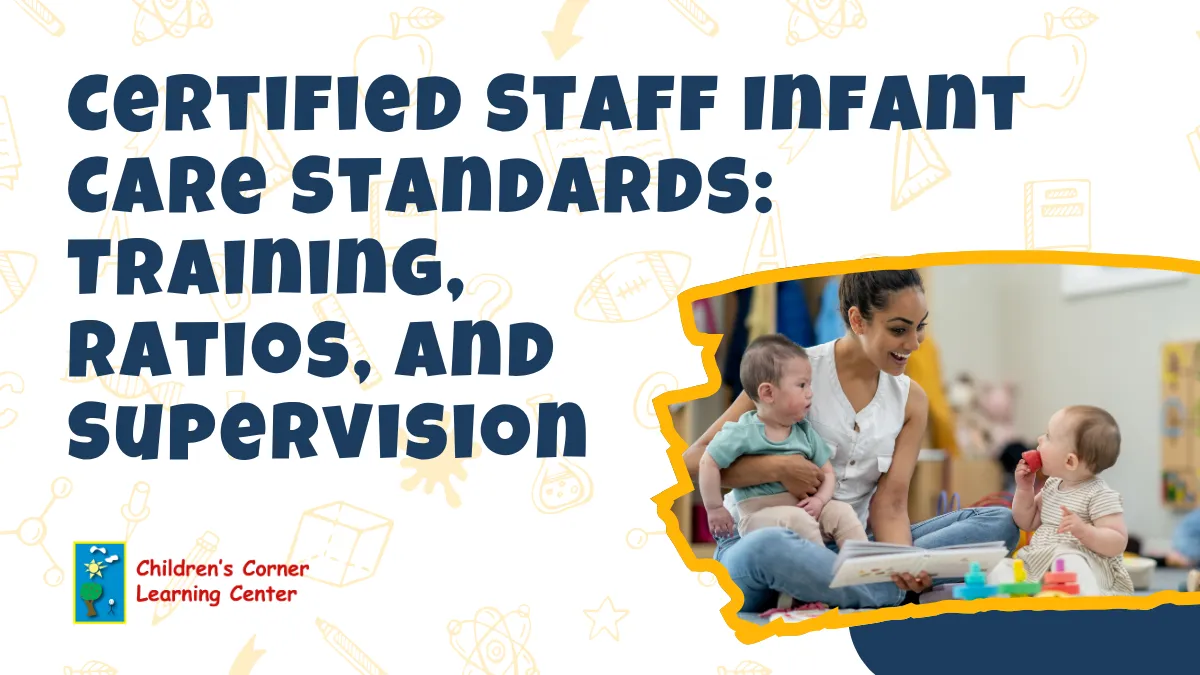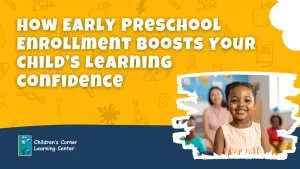Infant care, health, and safety services form the foundation of a dependable early childhood program. Families need secure entry systems, vigilant supervision, and clear check-in procedures that protect every classroom. Daily wellness screening, sanitizing routines, and safe sleep practices reduce risk and support healthy development. Trained caregivers follow protocols for bottle handling, handwashing, and crib checks while monitoring cues and documenting care.
Nutrition plans align with family preferences and pediatric guidance, with labeled storage and accurate tracking. Real-time communication informs parents about naps, bottles, and comfort; emergency plans are practiced and posted. These safeguards create a calm, predictable environment for the first year.
Infant Illness Prevention Daycare Policies: Daily Screening and Hygiene

A consistent health framework protects infants, families, and staff. Policies focus on early detection, clean environments, and clear communication so routines remain calm and predictable throughout the day.
Daily Wellness Screening
- Arrival check: Visual scan for alertness, breathing, skin tone, and comfort.
- Temperature policy: Follow program thresholds and document results when indicated.
- Symptom review: Ask about overnight fever, cough, vomiting, or diarrhea.
- Travel and exposure notes: Record recent exposures and physician guidance when relevant.
Hand Hygiene And Classroom Cleanliness
- Scheduled handwashing: Before bottles, after diapering, after outdoor play, and when switching tasks.
- Teacher routines: Soap-and-water wash for at least 20 seconds; sanitizer only when sinks are unavailable.
- Surface cleaning: High-touch areas are wiped throughout the day; toys are rotated and sanitized between groups.
- End-of-day sanitizing: Cribs, mats, handles, and sinks receive a deeper clean with approved products.
Diapering, Bottles, And Laundry Protocols
Teachers follow step-by-step procedures that reduce cross-contamination and protect delicate skin. Diapering areas are disinfected after each change, and gloves are discarded immediately. Bottles are labeled, stored at safe temperatures, and warmed using program-approved methods.
- Diapering sequence: Clean surface, put on fresh gloves, change, bag waste, remove gloves, wash hands, and sanitize area.
- Bottle handling: Label, store, warm safely, test temperature, log intake, and note cues.
- Laundry care: Soiled items are bagged, labeled, and sent home or laundered per site policy.
Illness Exclusion And Return-To-Care
- Immediate exclusion: Fever above policy threshold, persistent vomiting, diarrhea, undiagnosed rash, or significant respiratory symptoms.
- Care coordination: Contact families promptly and provide a quiet, supervised space until pick-up.
- Return criteria: Symptom-free period per policy, physician note when required, and the child’s ability to participate comfortably.
- Documentation: Record time of symptom onset, actions taken, and family notifications.
Communication And Recordkeeping
Families receive timely updates about health observations, classroom cleaning, and any policy changes. Logs document screenings, sanitizing schedules, and product use, creating a clear audit trail for quality assurance. When community guidance changes, the center shares updates, revises checklists, and retrains staff so practices remain current and consistently applied. This structured approach keeps infant rooms healthy, orderly, and ready for safe exploration.
Certified Staff Infant Care Standards: Training, Ratios, and Supervision

High standards begin with qualified educators, clear procedures, and consistent oversight. These practices protect health and safety while supporting warm, responsive care throughout the infant day.
Staff Qualifications And Training
- Infant development: Milestones, cue reading, and responsive caregiving guide daily interactions.
- Safe sleep certification: Back-to-sleep, clear cribs, and scheduled crib checks are reinforced in training.
- First aid and CPR: Current certifications are maintained and posted per program policy.
- Health and hygiene: Handwashing, sanitizing, and illness reporting follow written procedures.
- Bottle feeding and nutrition: Labeling, storage, warming, and intake tracking ensure accuracy.
- Mandated reporter training: Staff understand reporting duties and documentation steps.
- Emergency readiness: Evacuation routes, shelter-in-place plans, and drill participation are required.
Ratios And Classroom Coverage
Low teacher-to-child ratios support safety and individualized attention. Classrooms are staffed to meet or exceed state requirements during all operating hours, including opening, transition times, and closing. Floaters or support staff provide coverage for breaks and planning so ratios never lapse. Schedules emphasize continuity of care, allowing infants to build secure relationships with familiar caregivers.
Coverage practices include:
- Pre-planned schedules: Daily staffing grids confirm ratios by time block.
- Real-time adjustments: Supervisors redeploy floaters when enrollment patterns shift.
- Contingency plans: Backup contacts and on-call support stabilize coverage during absences.
Supervision, Observation, And Safety Checks
Active supervision is continuous and intentional. Teachers position themselves to see and hear every child, remove visual barriers, and remain within arm’s reach during floor play and transitions. Name-to-face counts verify attendance at every transition, and crib checks are logged at set intervals.
- Zone supervision: Staff assign clear areas to prevent gaps in visibility.
- Head counts and rolls: Verified at arrival, before and after outdoor play, and departure.
- Crib safety: Labeled cribs, fitted sheets, and documented checks maintain compliance.
- Incident response: First aid steps, family notification, and written reports follow policy.
Ongoing Coaching And Quality Assurance
Leaders observe classrooms, provide feedback, and schedule professional development tied to infant best practices. Checklists track hygiene routines, supervision quality, and documentation accuracy. Audit results are reviewed with staff, and action plans are recorded to sustain improvement. This continuous cycle maintains high standards and a safe, calm environment for every infant.
Safe Sleep Practices in Infant Daycare: Cribs, Checks, and Documentation
Safe sleep is maintained through clear procedures, trained staff, and consistent recordkeeping. Classrooms use labeled cribs, clean bedding, and documented checks so every nap is supervised and predictable.
Crib Setup And Sleep Environment
- Clear cribs: Only a fitted sheet is used; no blankets, pillows, or stuffed items.
- Individual labeling: Each crib and sheet set is assigned to one infant to prevent mix-ups.
- Ventilation and spacing: Cribs are placed away from cords or window coverings for airflow and visibility.
- Cleanliness routine: Mattresses and rails are sanitized on a schedule and after soiling.
Safe Sleep Procedures And Checks
- Back-to-sleep placement: Infants are always on their backs unless a physician’s note specifies otherwise.
- Regular intervals: Visual and tactile checks are logged at set times during every nap.
- Positioning awareness: If an infant rolls independently, the sleep area remains clear, and checks continue.
- Wake windows and cues: Teachers coordinate nap timing with family guidance and the child’s cues to reduce overtiredness.
Monitoring, Documentation, And Communication
Accurate records support safety and transparency with families.
- Nap logs: Start and end times, check intervals, and observations are recorded.
- Crib check sheets: Staff initial time-stamped checks to verify supervision.
- Incident documentation: Any unusual breathing, color change, or distress is noted and escalated per policy.
- Family updates: Daily summaries share nap length, settling time, and any adjustments to routines.
Health Considerations And Exceptions
- Medical plans: Physician directives for reflux or other conditions are kept on file and reviewed with staff.
- Temperature checks: Room temperature is monitored; appropriate sleep clothing is discussed with families.
- Illness protocols: If a child appears unwell, staff follow exclusion and return-to-care criteria and notify families promptly.
Soothing, Transitions, And Staff Readiness
- Calm settling: Gentle patting, quiet singing, and dim lights help infants relax without adding items to the crib.
- Consistent routines: A brief pre-nap routine signals sleep while aligning with home practices.
- Staff training: Safe sleep policy, emergency response, and crib-check procedures are reviewed regularly.
- Quality assurance: Supervisors audit logs and crib setups, provide feedback, and retrain as needed.
These practices create a safe, calm environment for rest while giving families clear visibility into how naps are supported and monitored daily.
Family Communication, Incident Reporting, and Emergency Readiness
Clear communication and prepared responses keep infant classrooms calm and predictable. Families receive timely updates, incidents are documented with care, and emergency plans are practiced so everyone understands roles and next steps.
Daily Communication Protocols
- Consistent updates: Summaries cover bottles, naps, diapers, and activity highlights.
- Preferred channels: Families select an app, email, or in-person check-ins for routine messages.
- Two-way input: Parents share sleep notes, feeding changes, and comfort items to align routines.
- Privacy standards: Child information is shared only with authorized adults listed on file.
Incident Reporting Steps
- Immediate care: Staff provide first aid within training guidelines and notify a supervisor.
- Family notification: A phone call outlines what happened, the care provided, and the child’s current status.
- Written report: Time, location, witnesses, actions taken, and follow-up recommendations are documented and signed.
- Review and follow-up: Leadership reviews causes, updates risk controls, and confirms the family receives a copy.
Emergency Preparedness And Drills
- Posted plans: Evacuation routes, shelter-in-place steps, and relocation sites are displayed and reviewed with staff.
- Regular drills: Evacuation and lockdown drills occur on a set schedule, with outcomes logged and improvements recorded.
- Supply readiness: Emergency kits include child rosters, contact information, first aid materials, and age-appropriate supplies.
- Reunification process: Name-to-face counts, ID checks, and a designated pick-up area ensure safe release to authorized adults.
Health Alerts And Classroom Notices
- Exposure notifications: Families receive timely notices for communicable diseases per policy and public health guidance.
- Temporary measures: Cleaning schedules, mask policies, or cohorting adjustments are communicated with effective dates.
- Return criteria: Clear timelines and physician notes (when required) are outlined before a child returns.
Documentation And Quality Assurance
- Recordkeeping: Communication logs, incident forms, and drill records are maintained and audited.
- Program reviews: Supervisors observe classrooms, verify ratio coverage, and check signage and supplies.
- Staff refreshers: Brief trainings reinforce reporting steps, radio or phone protocols, and role assignments.
Family Partnership Throughout The Year
- Orientation and updates: Enrollment packets, calendars, and policy summaries set expectations.
- Conferences and surveys: Scheduled meetings and feedback tools surface priorities and refine practices.
- Open contact path: Families know whom to call for routine questions, urgent issues, or after-hours concerns, ensuring fast responses and consistent support.
Conclusion
A dependable infant program protects health, safeguards daily routines, and supports early development through qualified staff, clean environments, and vigilant supervision. Clear policies guide wellness screening, safe sleep, bottle handling, and classroom hygiene, while documentation and family updates create transparency. When caregivers follow consistent procedures and partner with parents on goals and preferences, infants experience calm transitions, steady comfort, and safe opportunities to explore and grow.
Book a tour to see how these safeguards work in real classrooms. Schedule at https://www.childrenscornergroup.com/book-a-tour/ or call (845) 250-5492 to discuss availability.










